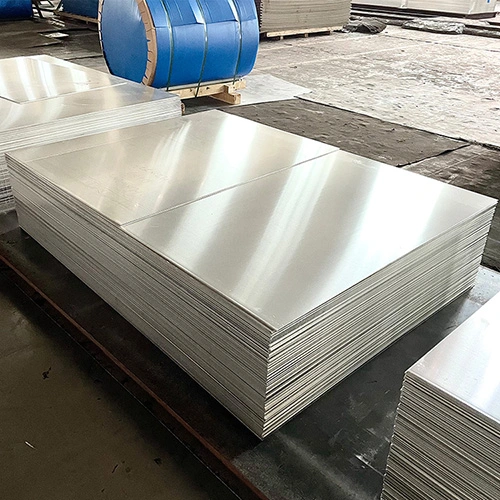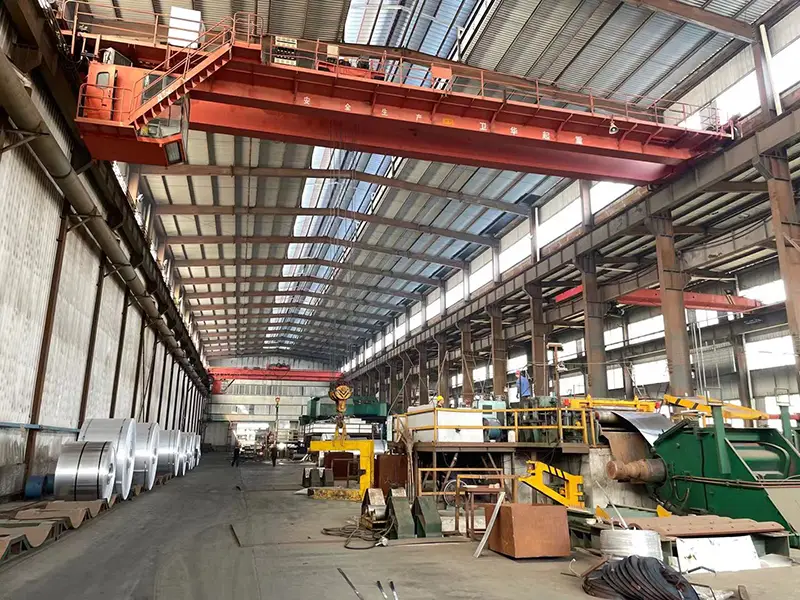
Yongsheng 6000 Series Aluminium Sheet Introduction
6000 series aluminium sheet alloys are mainly composed of aluminium (Al) as the main element and magnesium (Mg) and silicon (Si) as the main alloying elements. The mechanical properties of 6000 series aluminum sheets depend on alloy composition, tempering process, heat treatment and other factors. In general, these alloys exhibit good tensile strength, elongation, and yield strength. The thermal conductivity of 6-series aluminum alloys is generally high, ranging from 150 to 200 W/m K, and the electrical conductivity is about 30% to 40% of the International Annealed Copper Standard (IACS). The hardness of the 6-series aluminium alloys may vary depending on the tempering process and alloy composition. Generally, it is available in a range of hardness values from relatively soft to moderately hard, allowing relative flexibility in a variety of applications. This type of aluminum plate is usually very strong and can withstand huge loads and pressures.
Yongsheng can provide various 6000 series aluminium alloys, including 6005, 6061, 6063, 6082 and so on.
How Is 6000 Series Aluminum Made
Melting: The aluminum ingot is melted into aluminum water at high temperature in the furnace, and becomes molten alloy after cooling.
Casting: Casting molten aluminum alloy into the desired shape or form. The most common casting methods include permanent mold casting, die casting or continuous casting, depending on the specific application and requirements.
Heat treatment: Two common heat treatment processes are solution heat treatment and aging treatment. Solution heat treatment involves heating an alloy to a specific temperature and then rapidly cooling it (quenching) to stabilize the solid solution. Aging, also known as precipitation hardening, is the process of reheating the alloy to a lower temperature to allow the formation of strengthening precipitates within the aluminum matrix.
Cold working: After heat treatment, aluminum can be further processed through cold working techniques such as rolling, extrusion or forging. These processes involve deforming the material at room temperature to improve its mechanical properties, including strength and hardness.
Finishing operations: The final step involves finishing operations such as cutting, machining, surface treatment (such as anodizing or painting) and quality inspection to meet the specific requirements of the intended application.

Unique Advantages Of 6000 Series Aluminium Sheets
The 6000 series aluminium sheet has unique advantages that are different from the 1000 series aluminum sheet, 3000 series aluminum sheet, 5000 series aluminum sheet and other series of aluminum plates.
| SERIES NUMBER | ADVANTAGES | REPRESENTATIVE ALLOY |
| 1000 series aluminium | High purity at an affordable price | 1050,1060,1100 |
| 2000 series aluminium | High hardness | 2A16,uncommonly used |
| 3000 series aluminium | Anti-rust aluminum plate, the price is higher than 1xxx aluminum | 3003,3004,3105 |
| 4000 series aluminium | high silicon content | 4A01 |
| 5000 series aluminium | Aluminum-magnesium alloy, low density, high tensile strength, high elongation | 5052,5005,5083,5754 |
| 6000 series aluminium | Magnesium-silicon alloy, strong, corrosion-resistant, weldable, and coatable | 6061,6063 |
| 7000 series aluminium | Aluminum-magnesium-zinc-copper alloy, heat treatable, superhard and wear-resistant | 7075 |
| 8000 series aluminium | Lightweight, durable and high performance | 8011,8021,8079,8006,1235 |
Compared with 1000 series aluminium sheet, 6000 series aluminium plate has higher strength. It forms alloys with elements such as magnesium and silicon, which help enhance its mechanical properties. This makes it suitable for structural components in the aerospace, automotive and marine industries; compared to some other high-strength aluminum alloys, 6000-series aluminum sheet offers a good balance of performance and cost-effectiveness without creating excess material cost.
6000 series aluminium sheet can be easily welded using a variety of techniques such as MIG welding, TIG welding and resistance welding. Although not as corrosion resistant as the 5000 series aluminium sheets, the 6000 series still has good atmospheric corrosion resistance. Its alloying elements provide a protective oxide layer on the surface that helps prevent corrosion in most environments. However, for more severe corrosive conditions, additional protective coatings or treatments may be required. 6000 series aluminum plate can also be used for cutting, drilling, milling and turning operations. It produces small chips during machining, resulting in better chip control and reduced tool wear.
One of the outstanding advantages of 6000 series aluminium sheet is its heat treatability. It can be subjected to various heat treatments, such as solution heat treating and precipitation hardening, allowing manufacturers to tailor the strength and hardness of the material to specific application requirements.
6000 Series Aluminium Strength Description
Common alloying elements in 6000 series aluminum alloys include silicon, magnesium and manganese. The addition of these elements can improve the tensile strength and corrosion resistance of the alloy. This series generally has medium to high strength levels to meet many structural and engineering requirements. Generally, 6xxx aluminum is further enhanced by heat treatment processes, including aging treatment (T4, T5, T6) and artificial aging treatment (T7, T8). Of course, the 6000 series aluminum alloy can also be processed by cold deformation, such as rolling, extrusion and drawing, etc., and has high toughness.
Main Grades Of 6000 Series Aluminium
6005 Aluminum Sheet
6005 aluminum sheet has medium strength, high toughness and weldability, making it suitable for various structural applications. The alloy composition contains silicon and magnesium to increase strength and improve formability. In addition, 6005 aluminum sheet is easy to extrude and can produce complex shapes and profiles.
From the application point of view, 6005 aluminum plate is widely used in construction, transportation, automobile and other industries. Its combination of strength and formability makes it ideal for structural components such as beams, columns and trusses in buildings and bridges. The ability to extrude complex profiles can produce lightweight, durable parts for the transportation industry, including railings, frames and body panels. In the automotive sector, 6005 aluminum sheets are used in the manufacture of chassis components, heat exchangers and body reinforcements. Yongsheng 6005 aluminum plate is often used in the manufacture of fuel tanks/pipes, sheet metal parts of transportation vehicles/ships, etc.

6061 Aluminum Sheet
6061 aluminum sheet is a reliable, versatile material for applications requiring high strength, formability, and corrosion resistance.
6061 aluminum plates are often used in structural parts such as frames, beams, and brackets. 6061 aluminum sheet is also used in marine applications such as hulls and decks due to its saltwater corrosion resistance. It is also used in electrical enclosures, heat sinks and other electronic components. In summary, 6061 aluminum sheet is a versatile material that is easy to machine and weld, making it ideal for custom designs and prototyping. Yongsheng 6061 aluminum is often used in mobile phone card slots, mobile phone cases, molds, automobiles, mask machines, precision machining, etc.
6063 Aluminum Sheet
6063 aluminum sheet is known for its excellent formability, corrosion resistance and thermal conductivity. It has a good surface finish and can be easily anodized or painted, making it ideal for decorative applications. It also has good electrical conductivity and is non-magnetic, making it suitable for electrical applications.
6063 aluminum sheets are widely used in automobile floor plates, truck hubs, mobile phone casings, precision molds, etc. It is also used in decorative applications such as trim and moldings due to its excellent surface finish and anodizing capabilities.

6082 Aluminum Sheet
6082 aluminium sheet has high strength, formability and corrosion resistance. It is a heat treatable alloy that can be strengthened by heat treatment, making it ideal for structural applications requiring high strength.
6082 aluminium sheet is widely used in industrial, automotive and construction industries. Yongsheng 6082 aluminum is often used in mobile phones, camera lenses, industrial molds, etc. In the automotive industry, for engine components, suspension components and other structural components. In the construction industry, it is used in structural components such as beams, columns and trusses, as well as in roofs and cladding. Additionally, 6082 aluminum sheet is commonly used in marine applications due to its resistance to salt water corrosion. It is also used in the production of high-pressure containers, heat exchangers, etc.
FAQ:
What Is The Strongest 6000 Series Aluminum?
Among the 6000 series aluminum alloys, the strongest and most commonly used one is 6061 aluminum alloy. It offers a good combination of strength, formability and weldability, making it suitable for a wide range of applications. It has a tensile strength of approximately 45,000 psi (310 MPa) in the annealed condition and can be further strengthened by heat treatment processes such as precipitation hardening, such as 6061-T6 aluminum in the annealed condition. Other high-strength alloys in the 6000 series include 6005, 6063 and 6082, each with slightly different properties and applications.
Does 6000 Series Aluminum Lose Strength When Welded?
When welding 6000 series aluminum, its strength may be reduced, especially in the heat-affected zone (HAZ) near the weld. This is because the welding process introduces heat, which affects the material’s microstructure and mechanical properties. A common phenomenon that can occur during welding of precipitation-hardened alloys such as 6061 is the formation of a softened zone in the heat-affected zone, called a “nugget zone.” This area is usually less strong compared to the base material. However, post-weld heat treatments, such as artificial aging, can be used to restore or even improve the strength of the weld and adjacent areas.
What Is The Toughest Aluminum?
In terms of toughness, 7000 series aluminum alloys are generally considered the toughest. Known for their high strength and excellent fatigue resistance, 7000 series alloys are suitable for demanding applications in the aerospace, defense and sports industries. The aluminum alloy 7075 in the 7xxx series aluminum is known as one of the strongest aluminum alloys.


